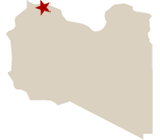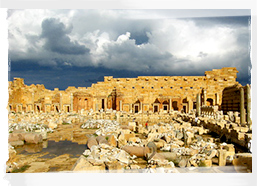An Introduction to Libya
Libya was inhabited by Berber tribes in ancient times, ruled by various Arab empires until 1551 and by the Ottoman Empire until 1911, and united in something like its present form as Italian Libya from then until its independence in 1951. See full country profile.Latest Research News from Africa
1 current African job:

GOVERNMENT: transitional... see right
AREA: 1,759,540 sq km
POPULATION: 6,597,960 (July 2011 est.) - includes 166,510 non-nationals
MAJOR LANGUAGE: Official Language: Arabic

Some business and general info
The Market Research Industry
Trade and Industry in Libya
A little More Knowledge?
Go to next country
Libya was inhabited by Berber tribes in ancient times, ruled by various Arab empires until 1551 and by the Ottoman Empire until 1911, and united in something like its present form as Italian Libya from then until its independence in 1951.
A kingdom until 1969, the country then saw a coup d'ãtat and became the Libyan Arab Republic, led by Colonel Muammar Gaddafi for the next 42 years. After popular movements overturned the rulers of Tunisia and Egypt, its immediate neighbours to the west and east, Libya experienced a full-scale revolt beginning on 17 February 2011. On 27 June 2011, the International Criminal Court issued an arrest warrant for Gaddafi, and on Thursday 20th October 2011) he was killed while fleeing his home town of Sirte, whose capture marks the effective end of the civil war. The National Transitional Council, led by Mustafa Abdul Jalil, is the new de facto power throughout the country.
GDP: $90.57 billion (2010 est.) - $14,000 per capita (2010 est.)
Religions Sunni Muslim (official) 97%, other 3%
Currency: Dinar (LYD) - GBP 1 = LYD 1.95
Telephone Code: + 218
Libya's oil industry accounts for almost all export earnings and about a quarter of GDP. After the discovery of oil in 1959 Libya went from being the poorest country in Africa to the richest, and as recently as the 1980s it was one of the richest countries in the world having a higher GDP than Italy, Singapore, South Korea, Spain and New Zealand. Today it still has one of the highest GDPs per capita in Africa. The majority of wealth is held by relatively few people, but levels of absolute and relative poverty are still low compared to other countries in the region.
Climate and poor soils mean agricultural output in Libya is severely limited and around 75% of food is imported. Some 28% of the population don't have access to clean drinking water, although the Great Manmade River project is aiming to tap in to vast underground reserves of fresh water which should help.
The head of the Libyan Stabilisation Team estimates that it will take around ten years to rebuild Libya's infrastructure, the destructive war having followed years of 'utter neglect' by the Gaddafi administration.
Libya exported $46.3bn of goods in 2010, including crude oil, petrol products, gas and chemicals, with Italy the largest export partner - others were Germany, France, China, Spain and the USA. Imports totalling $24.6bn included machinery, food and consumer products, again with Italy the major partner but with many other regions of Europe, Asia and Africa involved.
Email me:
laurence@mrweb.com

